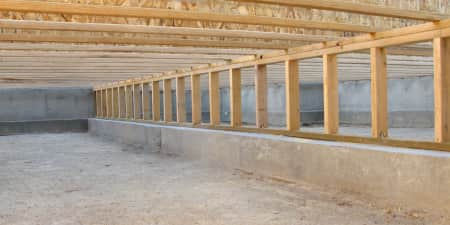Crawlspace Foundations: the Pros and Cons
At first glance, an empty, 4-foot-tall space beneath a house may seem like an odd setup, but crawlspace foundations actually have a lot of functionality. Depending on where your job site is, what its soil composition looks like, and the project's budget, this foundation style may be the best option as the base of your structure.
What's a crawlspace?
Crawlspaces are one of three main foundation types, among full basement and slab foundations. It's defined as the area found between the ground and a home's first floor. They're usually positioned at least 18 inches or more above the ground, while its walls sit atop footings. Most of the time, crawlspaces are only 2 to 4 feet tall.
You can enter a crawlspace through the basement, if its floor is flesh with the basement, or from an entrance external to the home. Furnaces, plumbing, and other wiring services are often located inside. If the area is equipped with ventilation, internal walls, and finished flooring, it also serves as a storage space.
Is a crawlspace right for you?
The pros and cons of crawlspaces are largely dependent on the area you're building since this foundation style is better suited to some soil conditions over others. So, once you've established the area your foundation will sit upon, the decision is mostly based on personal preference. There are a few considerations to take into account in making the decision.
Access
When it comes to crawlspaces, access has a dual meaning. When pipes and wires are run through the area, homeowners are given better access to plumbing and HVAC services. Whereas in slab foundations, an alternative foundation type made from large slabs of concrete, pipes run either underneath the slab or are encased within the slab itself. In the event of repairs, it's much easier to access essential services with this type of foundation.
The flip side to access is physically entering the space. Since you have to physically crawl into a crawlspace to access anything inside of it, homeowners will experience a mobility barrier with concrete crawlspace foundations.
Due to its size and location, identifying cracks within the crawlspace's foundational walls is harder to do compared to concrete slab foundations.
Soil Conditions
The soil located beneath the foundation plays a huge role in whether some crawlspace characteristics are pros or cons in your decision criteria.
Crawlspace foundations are best suited for homes built on uneven soil that's prone to sliding. These foundations address the issue of shifting soil by leveling the base of a structure. For example, part of a crawlspace may be level with the basement, while the other portion props up the home's first floor above the basement level. This can be achieved using columns and footings in certain areas of the foundation.
On job sites with shifting, non-level soil, it would require much more excavation to construct a slab foundation. You'd have to excavate more dirt from one side to level the ground and pour the concrete slab. Ultimately, crawlspaces work around uneven dirt, so they require less excavation.
Soil Moisture Content and Humidity
Oddly enough, foundational crawlspaces work best in three extreme climates: dry, flood-risk, and frozen areas. They are prone to accumulating water, seepage, and mold. This is particularly an issue in spaces with unfinished, dirt floors. So, building crawlspaces in dryer soil conditions is a better call to prevent water damage. Slab foundations are a better alternative in moderately wet and humid areas.
However, too much moisture in the soil, which occurs in flood-risk areas, can seep into concrete slab foundations, causing them to crack and shift upwards, which reduces their load-bearing capacity. The impact of excess humidity is even greater when water freezes. Choosing a crawlspace over a slab foundation is a better call in flood-prone areas.
Ventilation
Crawlspaces are known for being poorly ventilated areas. If left uninsulated and unheated, the air quality can be quite poor. This isn't ideal if you're planning on using the space for storage, as items can be damaged by excess moisture and exposed dirt. However, finishing the space with wood or concrete floors and ventilating the space will mitigate these issues.
Cost of Construction
Since crawlspaces require less excavation, they have a lower material and labor cost than slab foundations and full basements. However, heating and cooling a home that has a crawlspace is very expensive. Even after being ventilated, this tis type of foundation drives up energy bills significantly.
Crawlspace foundations cost $8,000 - $24,000 to build on average according to HomeAdvisor. Slab foundations are slightly less expensive overall, as their costs range from $7,000 - $20,000. Full basements, which are built using foundational walls set atop footings, are the most expensive option. They range from $24,000 - $44,500.
Choosing the Best Foundation Style
When it comes to crawlspace functionality, there's more there than what meets the eye. In cold, dry climates and non-level soil, crawlspace foundations are the best foundation option. Properly ventilating and heating the area will prevent excess moisture and other headaches. If it fits the budget and job site well, choose the crawlspace foundation.
For your next foundation project, consider DOZR's rental equipment marketplace for excavators, backhoes, and other earth-moving equipment!
FAQs about Crawlspace Foundations
What is the difference between a crawlspace and a slab foundation?
Slab foundations are made of flat pieces of concrete that bear a structure's load. With a slab foundation, there's no space between the structure and the concrete slab. Whereas crawlspace foundations create empty space between the base of the structure and the ground since the space created between the four walls and their respective footings isn't filled with concrete.
How do you build a crawlspace foundation?
This foundation style is built by excavating the area where footings will rest, pouring footings, then pouring the walls. Insulation, vapor barriers, and ventilation should be installed as well.

